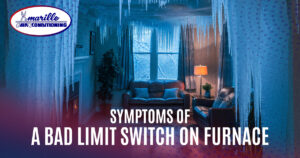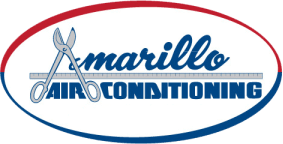Symptoms of A Bad Limit Switch on Furnace

A furnace limit switch is an important part of your heating system’s safety and efficiency. Recognizing the symptoms of a bad limit switch on your furnace and basic troubleshooting steps can help you prevent further damage, practice proper maintenance, and know when to call a professional in Amarillo Air for help.
What Is a Furnace Limit Switch and How Does It Work?
The furnace limit switch is a safety device that regulates the temperature in your furnace. Composed of two components — a mounting plate and a temperature probe — the switch is located near the heat exchanger and under the supply plenum, giving it access to the components responsible for heating the air. Also called the high limit switch or the fan limit switch, this device serves two main purposes:
- Overheating prevention: The limit switch prevents the furnace from overheating. It constantly monitors the temperature within the furnace’s heat exchanger or combustion chamber. If the temperature exceeds a preset threshold, the switch triggers and cuts off the burner or gas supply.
- Controlling the fan blower: During a heating cycle, the limit switch controls the furnace’s blower fan. When the heat exchanger warms the air to a set temperature, the limit switch signals the blower to turn on and circulate warm air throughout the home. It shuts down the blower at the end of the cycle, then repeats this process as needed.
Common Symptoms of a Bad Limit Switch on Furnace
Several signs point to a bad furnace limit switch. Knowing these signs can help alert you to furnace problems before they escalate and cause further damage.
No airflow
If the furnace is on but the blower fan isn’t running, the limit switch may have failed. If the switch fails to turn on the blower fan at the appropriate time, warm air can’t circulate throughout your home.
Cold air
Inversely, a faulty limit switch may activate the blower fan before the furnace has adequately warmed the air. If the switch doesn’t accurately detect air temperature, the fan can push cold air through your ductwork and vents and inadvertently cool your home.
Short cycling
Whether due to incorrect calibration, electrical problems, faulty resetting, or overheating, a malfunctioning limit switch may trip at a lower temperature than it should. As a result, your furnace ends its cycles before adequately heating your home, which means it’ll quickly restart its heating cycle. This short-cycling process hurts your furnace’s efficiency and causes extra wear to the system’s components.
Constant running
If the limit switch is stuck in the closed position, the blower fan may run continuously, even after the furnace has reached the set temperature.
Overheating
Malfunctioning limit switches may not reset properly or fail to detect high temperatures. If the furnace runs too hot, the faulty limit switch can’t trigger a safety shutdown.
How to Test a Furnace Limit Switch
To troubleshoot your furnace limit switch, start by checking for simple fixes and overdue maintenance that may be contributing to or causing symptoms. These include:
- Replace air filter: Inspect the air filter for dirt or clogging. Replace the air filter if necessary.
- Inspect vents: Check the vents throughout your home, ensuring they’re open and unobstructed by furniture or other items.
- Check thermostat: Make sure your thermostat is set to heat and at the correct temperature set point, about 68 degrees.
If these steps don’t resolve your heating concerns, move on to resetting the furnace limit switch. Start by locating your electrical panel and turning off the breaker that controls your furnace power. Refer to the owner’s manual for your furnace to locate the control panel — pull it away from the unit, and set it aside.
Look for a red or yellow switch near the ignition control box. Push and release the switch to manually reset the limit switch. Restore power at the electrical panel after returning the control panel to its position. If your furnace continues to show symptoms, it likely needs diagnosis and repair from a professional technician.
Causes of Limit Switch Malfunction
Several factors can lead to furnace limit switch malfunction and other furnace problems. Common causes include:
- Age: Limit switches may wear out over time. Internal contacts can degrade and cause malfunction.
- Poor airflow: Restricted airflow, whether from a faulty blower motor, dirty air filter, clogged ductwork, or blocked vents, can cause the furnace to overheat and trip the limit switch.
- Overheating: A malfunctioning flame sensor, burner problems, or a cracked heat exchanger can cause the furnace to overheat, leading to irregular temperature and cycling that may damage the limit switch.
- Electrical issues: Power surges and damaged wiring may burn out internal components and prevent the limit switch from operating properly.
- Faulty circuit board controls: A malfunctioning control board may fail to signal the limit switch properly, preventing it from performing its key functions.
What to Do If You Suspect a Bad Limit Switch
If basic troubleshooting doesn’t restore proper function to your furnace, call a licensed HVAC technician for assistance. They can accurately read furnace limit switch error codes, diagnose the underlying problem, replace a faulty switch and other components, and keep your furnace functioning safely and efficiently.
Call Amarillo Air for Furnace Repair
Serving Amarillo and the surrounding Texas communities since 1955, Amarillo Air Conditioning is the go-to HVAC repair provider. From our fast repair response to preventative maintenance plans, learn how our team can keep your home comfortable and safe — contact us or book online today.
Frequently Asked Questions
How can I prevent furnace limit switch problems?
Preventing limit switch problems involves regular maintenance, which helps ensure proper airflow and smooth system operation. In addition to scheduling annual maintenance, regularly check your air filters and keep your vents open and unobstructed.
Can I run my furnace without a limit switch?
You shouldn’t run your furnace without a limit switch. This component is an essential safety device that prevents overheating, and running a furnace without it can lead to damage to your furnace as well as risks of fire and carbon monoxide leaks.
CONTACT Amarillo Air Conditioning, Inc.
100% Satisfaction
Our installation technicians are the best in skill, attitude and workmanship. They will care for your home and complete the job with speed and precision. They will not wear shoes on your carpets. They will clean up when they are finished and take personal responsibility for your satisfaction. They will not smoke or swear in your home and they are drug-free. If, when they have finished in your home, they have not performed in accordance with these high standards, we won't consider the job done until you are satisfied with the results.
